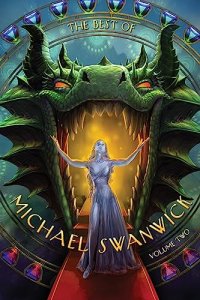Paul Di Filippo reviews Rudy Rucker
 Here’s a primer in the unique 21st-century, digital-mediated relationship between writers and readers, an illustration of how novels are often composed and marketed these days.
Here’s a primer in the unique 21st-century, digital-mediated relationship between writers and readers, an illustration of how novels are often composed and marketed these days.
If you are a regular follower of Rudy Rucker’s entertaining blog, where he generously posts intriguing essays and snazzy visual material, you will have been privy, over the past year or so, to reports of his creative endeavors on his latest novel, Turing & Burroughs. You will have seen fascinating posts where Rucker detailed the philosophical underpinnings of his project, his outlining and research tasks, his building of characters, and his actual writing methods, with raw snippets from the novel on display as well.
Following the completion of the book, you would also have gotten less frequent updates on the often frustrating marketing of the novel, and Rucker’s semi-hopeful, semi-reluctant decision to go the self-publishing route. After that, his blog served as a portal to purchasing the very handsome POD creation—the cover features one of Rucker’s own paintings—with the book of course also available at major online retailers.
All of this behind-the-scenes stuff—similarly visible on the sites of many other writers—can be Too Much Information for some readers (no one should see how law, sausages or books are made?), and pure catnip for others. Myself, I rather enjoy seeing the author publicly muck about in the guts of his creation. Yet of course there are Grandmasters like Jack Vance who have openly declaimed that they will never reveal the secrets of their magic. But on the whole, I think the social-media-zation of literary composition is pretty important and A Good Thing. What would historians of the field give for a similar record of the creation of, say, More Than Human or The Stars My Destination?
In any case, Rucker’s novel is now a tangible, buyable reality, and we can enjoy it and evaluate it in the most important way: as an independently existing esthetic artifact. We remain heedful and appreciative of the circumstantial preliminaries, but reliant on the text itself.
The book opens in 1954, with a gracefully channeled version of Alan Turing—that historically real cybernetic icon of misunderstood genius. The scene is set with vibrant verisimilitude, not a surprise when you consider Rucker’s previous well-done historical fiction such as The Hollow Earth and As Above, So Below. But Turing’s life soon goes counterfactual, and he’s on the lam to Tangier where he hooks up with William Burroughs, notorious louche Beatnik junkie and scribbler of transgressive fiction. The pair are made for each other. (Interspersed chapters consisting of letters from Burroughs to his Beat pals show that Rucker can effectively inhabit that idiosyncratic Burroughsian voice as well.)
Where does the SF come in? Right from the start, as Turing turns his talents away from circuitboards to biology. Pretty soon, out of dire necessity, he’s invented a totipotent shape-changing form of life—a “skug”—that establishes a strange symbiosis with him and Burroughs. And before you can say “blood music,” a hegira of infection is underway. Turing lands in Florida after a long, comic sea voyage, and with new comrades, infected and otherwise, conceives of a visit to the labs of Los Alamos, where the brand new invention of an H-bomb can be coopted for his plans.
Rucker accomplishes a significant feat by mashing up Greg Bear-level speculations with a kind of On the Road vibe, full of slang-laden hipster contempt for the Establishment and a desire to break free of stifling conventions. Turing’s adoption of Beat philosophy consorts perfectly with his known biographical proclivities, and seems extremely plausible and even predestined, once given the initial violent tweak to his career. The Eisenhower-era conformity and general societal suspicion of weirdos is a perfect adventure matrix for these ultimate outsiders: chimeric, telepathic slugs. That motif also rings changes on so many classic invasion movies of the 1950s. On a separate plane, this book reads like some newly discovered 1950s rival to Invasion of the Body Snatchers or The Thing from Another World, except of course with a certain taste of knowing irony from a 2012 perspective. It’s the closest Rucker has come to a Howard Waldrop story.
But it must be said that this latest novel by Rucker has a more somber and less joyous tone than most of his other books. Even with such immense and potentially fatal paradigm shifts as we saw in Postsingular and Hylozoic, the characters maintained a kind of joie de vivre and nonchalance that is not often on exhibit here. Most of the despairing, fugitive attitude is down to Turing’s personality and past history. Persecuted and slighted all his life, he feels naturally downtrodden and suspects that doom is around every corner.
But another part of the atmosphere derives from the Beats themselves. The description “beat” derived, simultaneously and paradoxically, from two poles of an emotional spectrum: beaten down, and beatific, with perhaps acceptance of the former condition leading to genesis of the latter state. Turing-plus-skug has the potential to embody that evolution, but along the way it’s all, like man, “the best minds of my generation destroyed by madness, starving hysterical naked, dragging themselves through the negro streets at dawn looking for an angry fix.”
That, along with man-sized telepathic orgy-loving slugs.








Pingback:Paul di Filippo Reviews Rudy Rucker’s New Work: Turing & Burroughs: A Beatnik SF Novel | Duckter Yezno's Weird Word Orb Spurts
Pingback:Locus Online Monitor » New Books, 23 October